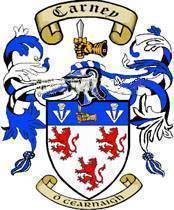
Carney & Wehofer Family
Genealogy Pages

Harold II Godwinson "The Saxon" King Of ENGLAND
-
Name Harold II Godwinson "The Saxon" King Of ENGLAND [1, 2, 3] Nickname The Saxon Birth Abt 1022 Sussex, England  [1]
[1] Gender Male RULED RULED [4] - 1066-1066
Name The Saxon _UID F699E9A18E1B4841BD08A664003460FDAB7D Death 14 Oct 1066 Battle Of Hastings, Sussex, England  [1]
[1] Person ID I10527 Carney Wehofer July 2025 Last Modified 5 Feb 2012
Marriage Y [1] - "Handfast" Wife - Non Christian Marriage
Family ID F5256 Group Sheet | Family Chart Last Modified 29 Aug 2016
Family 2 Ealdgyth De Taillebois Queen Of ENGLAND, b. Abt 1034, Saxe, Mercia, England  d. Aft 1086 (Age ~ 53 years)
d. Aft 1086 (Age ~ 53 years) Marriage Abt 1064 2ND Husband, 2ND Wife  [5]
[5] Family ID F5257 Group Sheet | Family Chart Last Modified 29 Aug 2016
-
Notes - on the history of the Earldom of Huntingdon:
There seems to have been an Earldom of Huntingdon before the Norman Conquest, among its holders then being King Harold, according to the chronicler Florence of Worcester, and Tostig, Harold's brother. [Burke's Peerage]
----------------------------------------
Harold II, also called HAROLD GODWINESON or GODWINSON (b. c 1020 - d. 14 Oct 1066, near Hastings, Sussex, England), last Anglo-Saxon king of England. A strong ruler and a skilled general, he held the crown for nine months in 1066 before he was killed at the Battle of Hastings by Norman invaders under William the Conqueror.
Harold's father, Godwine, Earl of Wessex and Kent, was the most powerful man in the kingdom early in the reign of Edward the Confessor (1042-1066). About 1044 Godwine, obtained for Harold the earldom of East Anglia. In 1051 Edward banished Godwine and his sons for defying royal authority, but Harold led the forces that in 1052 invaded England and forced the king to restore the family.
Upon Godwine's death in 1053, Harold succeeded to his father's earldoms and became the chief power in the land. By 1057 he had obtained earldoms for his three brothers, Tostig, Gyrth, and Lefowine. His only rival was the house of Leofric of Mercia. Leofric's outlawed son, Aelfgar, raided Mercia with help from the Welsh, and in retaliation Harold and Tostig subjugated Wales in 1063. In 1065 the Northumbrians revolted against Tostig, their earl. Bowing to rebel demands against Tostig, Harold gave Tostig's earldom to Morcar of the house of Mercia, but by doing so he made Tostig his bitterest enemy. Nevertheless, Harold's postiion remained unshaken.
On his deathbed Edward the Confessor had supposedly designated Harold the royal heir. Earlier, Edward had, however, promised the crown to William, Duke of Normandy. Moreover, Harold himself, when shipwrecked on the coast of Normandy, had been forced to promise to support William's claim. Hence, when Harold assumed power on the death of Edward (5 Jan 1066), he was immediately threatened with the rivalry of William and another royal claimant, Haral III Hardraade, king of Norway, as well as with the enmity of Tostig. In May, Harold mobilized his fleet and army against an expected invasion by William. Instead, he had to use his forces to repel Tostig's raids on the south and east coasts of England. He dismissed his men in early September because he had run short of supplies. Thus, William was free to cross the English Channel unopposed. Tostig and Harald III Hardraade joined forces and were defeated near York, on 25 Sep 1066. Three days later William landed near Hastings on October 14, and in an all-day battle the king, Gyrth, and Leofwine were killed. The accession of William to the English throne as King William I ended the Anglo-Saxon phase of English history. [Encyclopaedia Britannica]
- on the history of the Earldom of Huntingdon:
-
Sources - [S845] Ancestral Roots of Certain American Colonists, 7th Edition, by Frederick Lewis Weis, additions by Walter Lee Shippard Jr., 1999, 1b-23 (Reliability: 3).
- [S289] Burke's Peerage & Baronetage, 106th Edition, Charles M o s l e y Editor-in-Chief, 1999, 1474, 26 May 2003. (Reliability: 3).
- [S216] Encyclopedia Britannica, Treatise on, Godwine (d. 1053), Earl of Wessex (alleged descendant of Ae thelred I) (Reliability: 3).
- [S216] Encyclopedia Britannica, Treatise on, United Kingdom, Sovereigns of Britain (Reliability: 3).
- [S845] Ancestral Roots of Certain American Colonists, 7th Edition, by Frederick Lewis Weis, additions by Walter Lee Shippard Jr., 1999, 176a-4 (Reliability: 3).
- [S845] Ancestral Roots of Certain American Colonists, 7th Edition, by Frederick Lewis Weis, additions by Walter Lee Shippard Jr., 1999, 1b-23 (Reliability: 3).
